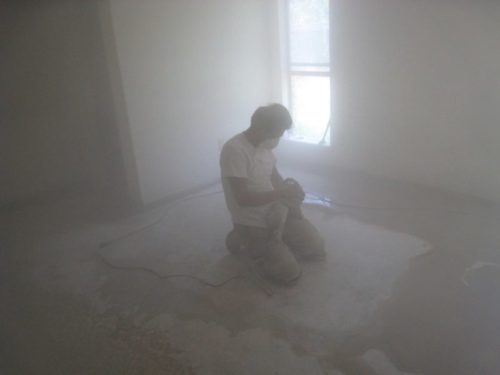With the introduction of OSHA’s new regulations regarding silica dust management, many division 3 contractors are having difficulty keeping up. The contractors waiting for their equipment companies to come up with new tech will be waiting a while.
Companies like HTC Floor Systems, Husqvarna, Skanmaskin, and more are recommending retrofitting current equipment and having properly matched vacuums to grinders.
Our current technology is adequately outfitted to handle high amounts of dust.
The machines do not need much upgrading besides a well-fitting dust shroud and the right sized vacuum. However, This can still not be a complete fix. Other options are available for your equipment are smaller but again prove to be quite effective.
Upgrading your filters should be one of your first targets. It is recommended to make sure all your filters are HEPA standard (high-efficiency particulate arrestance), and if you can fit it, self-cleaning filters are an incredible asset.
With self-cleaning filters, failing a silica dust test because an employee forgot to clean out his filters will no longer be a concern.
Outside of new equipment and retrofitting, we have two primary ways to go about grinding. The first and quickest way is dry grinding. The pucks cut through the concrete much faster than when wet. However, this type of grinding produces a large amount of silica dust. Next, there is wet grinding, which significantly reduces the amount of respirable dust. The main problem is that it creates a slurry, which is a mixture of water and dust.
The slurry can be difficult to contain and remove.
If not done soon enough the slurry will dry up back into silica dust. Besides the amount of dust, wet grinding also eliminates the need for a vacuum since the water keeps it on the floor. in the future we will be seeing some major improvements in wet grinding from equipment manufacturers.
Wets grinding systems continue to be improved each year.
These improvements result in less water being consumed, which creates less slurry to clean up all while maintaining a minimal amount of dust. Eventually, we will see new machines from our major manufacturers that will hopefully initiate integrated tools that will cut the need for extra equipment that results in hoses and cords laying around and inefficiency.
As innovation continues, job site hassles such as these that seem so common today will eventually begin to disappear as we learn and adapt our techniques and equipment to tackle each issue.
With the introduction of OSHA’s new regulations regarding silica dust regulations, many division 3 contractors are having difficulty keeping up. The contractors waiting for their equipment companies to come up with new tech will be waiting a while.
OSHA’s new regulations and grinders.
Companies like HTC Floor Systems, Husqvarna, Skanmaskin, and more are recommending retrofitting current equipment and having properly matched vacuums to grinders. Our current technology is adequately outfitted to handle high amounts of dust. The machines do not need much upgrading besides a well-fitting dust shroud and the right sized vacuum.
Other options are available for your equipment are smaller but still prove to be quite effective.
However, This can still not be a complete fix. Upgrading your filters should be one of your first targets. It is recommended to make sure all your filters are HEPA standard (high-efficiency particulate arrestance) and if you can fit it, self-cleaning filters are an incredible asset. With self-cleaning filters, failing a silica dust test because an employee forgot to clean out his filters will no longer be a concern.
Outside of new equipment and retrofitting, we have two primary ways to go about grinding.
The first and quickest way is dry grinding. The pucks cut through the concrete much faster than when wet. However, this type of grinding produces a large amount of silica dust. Next, there is wet grinding which significantly reduces the amount of respirable dust.
The main problem is that it creates a slurry which is a mixture of water and dust. This can be difficult to contain and remove. If not done soon enough the slurry will dry up back into silica dust. Besides the amount of dust, wet grinding also eliminates the need for a vacuum since the water keeps it on the floor.
In the future, we will be seeing some major improvements in wet grinding from equipment manufacturers.
Wets grinding systems continue to be improved each year which results in less water being consumed, which creates less slurry to clean up all while maintaining the minimal amount of dust.
Eventually, we will be seeing new machines from our major manufacturers that will hopefully initiate integrated tools that will cut the need for extra equipment that results in hoses and cords laying around and inefficiency.
As innovation continues, job site hassles such as these that seem so common today will eventually begin to disappear as we learn and adapt our techniques and equipment to tackle each issue. Please contact us should you have questions or want to schedule an appointment.
